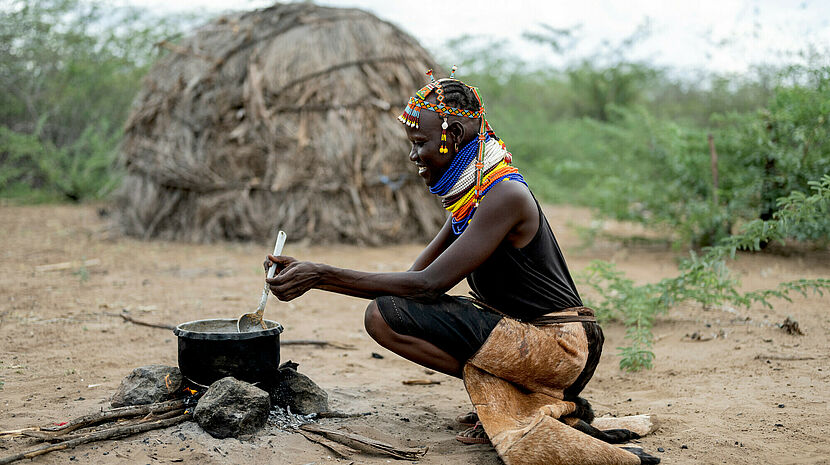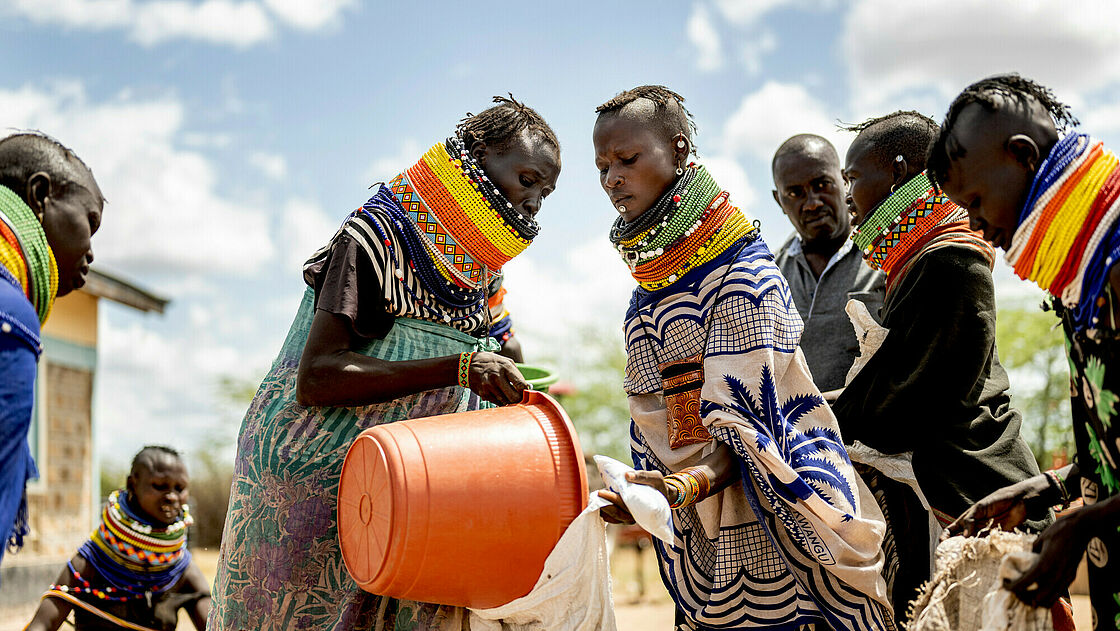Global insecurity crisis and its impact on persons with disabilities

Turkana, Kenya
CBM/Ackermann
Rising global food insecurity disproportionately affects persons with disabilities, highlighting the urgent need for inclusive solutions to address hunger and vulnerability.
Rising global food insecurity, as revealed by the State of Food Security and Nutrition in the World 2024, published by the United Nations, is a pressing issue. In 2023, a staggering 733 million people were affected, marking the third consecutive year of stubbornly high hunger numbers.
Persons with disabilities are disproportionately affected by food insecurity, particularly in rural and impoverished areas.
This urgent situation demands immediate attention as global crises continue to deepen.
In 2023, the scale of hunger was alarming, with 1 in 11 people worldwide facing this dire situation. The situation was even more severe in Africa, where 1 in 5 people were affected by hunger.
The causes of hunger are complex and multifaceted, ranging from armed conflicts such as in Ukraine, Sudan and the Middle East and extreme weather conditions to economic downturns and entrenched poverty.
For example, hundreds of thousands are fleeing the life-threatening floods in Nigeria today. A broken dam has exacerbated the situation. Drinking water is contaminated. Houses are washed away, and hospitals are overburdened.
Right now, persons with disabilities are in dire need. Addressing this issue requires comprehensive solutions.
The compounded challenges and impact of food insecurity for persons with disabilities
For persons with disabilities, the persistent global hunger crisis means facing even greater challenges in their daily lives.
Persons with disabilities face heightened vulnerability to food insecurity due to higher poverty rates, limited access to employment, and discrimination. This lack of economic opportunity makes it difficult to afford healthy food, creating a cycle where hunger exacerbates health conditions and impairments.
Inadequate nutrition also hinders their ability to participate fully in society, leading to further physical and cognitive challenges. Access to essential services like healthcare, education, and rehabilitation is often restricted, especially during crises, as households with persons with disabilities have less financial resilience. Additionally, barriers to food assistance—such as inaccessible registration processes, transportation issues, and distribution sites not designed for disabilities—further marginalise this group. Chronic health conditions and extra costs related to disability, such as medical expenses and assistive devices, increase the risk of malnutrition. For children with disabilities, missing out on school feeding programs only deepens the cycle of poverty and exclusion, perpetuating disadvantage across generations.
CBM's approach to addressing hunger

Food distribution in Turkana
CBM/Ackermann
At CBM, we understand that hunger and disability are closely linked. We address these issues by improving the quality of life for persons with disabilities by creating inclusive environments where everyone has equal access to nutrition, healthcare, education, and livelihood opportunities.
CBM actively addresses hunger and its impacts on persons with disabilities through several targeted initiatives. In regions like Turkana, Kenya, where extreme drought has severely impacted food and water availability, CBM collaborates with local partners such as the Africa Inland Church Health Ministries (AICHM) to provide essential food, water, and school meals as part of its humanitarian response. This support is crucial for persons with disabilities, who are often the hardest hit in such crises due to additional barriers they face in accessing aid.
Moreover, CBM's Inclusive humanitarian action approach focuses on creating sustainable and inclusive communities by integrating health, education, livelihood, and social activities. This approach ensures that persons with disabilities are included and supported, particularly in disaster-prone areas where food insecurity is prevalent. For example, in Marsabit, Kenya, CBM's "Cash Programme", in partnership with PACIDA (Pastoralist Community Initiative and Development Assistance), provides direct financial support to households with persons with disabilities, allowing them to purchase food and water. Or the project “Inclusive Food Security and Resilience in Togo” which supports persons with disabilities with disabilities with funds for livelihood projects.
According to the UN, there is still much work to be done as we are far from achieving the goal of eliminating global hunger and malnutrition by 2030. Forecasts indicate that 582 million people will be chronically undernourished in 2030, with half of them living in Africa.
The Need for Inclusive Financing
The theme of this year’s report: "Financing to end hunger, food insecurity, and all forms of malnutrition." It highlights the need to transform agrifood systems, address inequalities, and ensure affordable healthy diets for everyone. This should include persons with disabilities:
- Allocate resources for persons with disabilities to ensure equal access to essential services.
- Use innovative financing mechanisms to prioritise the needs of vulnerable populations, including persons with disabilities.
- Coordinate efforts to harmonise data and enhance transparency to accurately estimate funding gaps and mobilise resources. Data collection should include disaggregated information on persons with disabilities to ensure their needs are adequately addressed.
- Implement inclusive policy frameworks recognizing the specific needs of persons with disabilities in food security and nutrition policies.
To achieve SDG 2 Zero Hunger and ensure food security for all, it is essential to prioritise the needs of persons with disabilities. We can work towards a more equitable and inclusive future where everyone has access to safe, nutritious, and sufficient food.